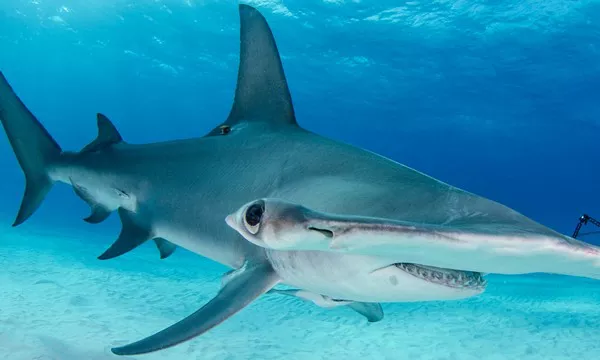The world beneath the ocean’s surface is a realm of mystery and fascination, home to some of the most awe-inspiring creatures ever to roam the Earth. Among these marine marvels, sharks stand out as apex predators, finely tuned by millions of years of evolution. In this exploration, we embark on a journey to uncover the secrets of the 10 largest shark species that rule the oceans, unraveling their incredible sizes, habitats, and the vital roles they play in maintaining the delicate balance of marine ecosystems.
Top 10 World’s Largest Shark Species
1. Whale Shark (Rhincodon typus):
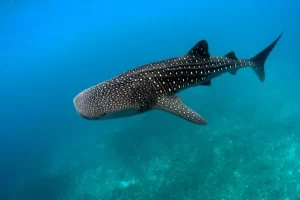
Claiming the title of the largest shark and fish species globally, the whale shark is a true marvel of the oceans. Contrary to its intimidating size, reaching up to 60 feet (18 meters) or more, the whale shark is a filter feeder, relying on plankton, small fish, and microscopic organisms for sustenance.
Global Presence:
Whale sharks are nomads of the oceans, traversing warm tropical waters worldwide. From the Indian Ocean to the Gulf of Mexico, these gentle giants embark on extensive migrations, capturing the attention and awe of those fortunate enough to witness their majestic presence.
Conservation Concerns:
While not directly targeted by commercial fisheries for their meat, whale sharks face threats from boat strikes, habitat degradation, and the impact of tourism. International conservation efforts aim to protect their migratory routes, regulate responsible tourism practices, and enhance our understanding of these magnificent creatures.
2. Basking Shark (Cetorhinus maximus):
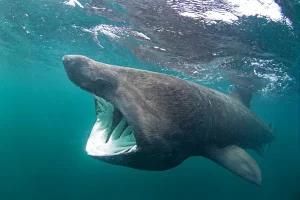
As the second-largest living shark species, the basking shark stands out for its distinctive filter-feeding behavior. Despite its enormous size, reaching lengths of up to 40 feet (12 meters) or more, this gentle giant poses no threat to humans.
Filter-Feeding Adaptation:
Unlike its predatory relatives, the basking shark lacks rows of menacing teeth. Instead, it cruises near the ocean’s surface, mouth agape, filtering plankton and small fish with its enormous gill slits. This unique feeding strategy sets it apart in the shark kingdom.
Conservation Status:
While not actively hunted for their meat, basking sharks face threats from entanglement in fishing gear and collisions with vessels. Conservation efforts focus on monitoring their populations, implementing protective measures, and raising awareness about the importance of preserving these remarkable filter feeders.
3. Megalodon (Carcharocles megalodon):
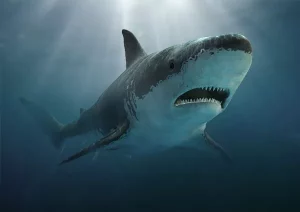
Although no longer patrolling the oceans, the megalodon deserves a mention for its unparalleled size and dominance in prehistoric times. Believed to have reached lengths of up to 82 feet (25 meters) or more, the megalodon was the largest shark ever to exist.
Prehistoric Reign:
Roaming the seas during the Miocene and Pliocene epochs, the megalodon was a formidable predator, preying on marine mammals like whales and seals. Its extinction remains a subject of speculation, with factors such as climate change and competition for resources playing potential roles.
Cultural Impact:
The megalodon’s colossal presence in the fossil record continues to captivate popular culture. Documentaries, books, and films explore the mysteries surrounding this prehistoric giant, contributing to its enduring cultural significance.
4. Great White Shark (Carcharodon carcharias):
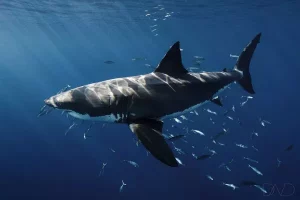
Renowned for its iconic appearance and often sensationalized in popular media, the great white shark is the quintessential apex predator of the oceans. With its streamlined body and rows of serrated teeth, it instills both fear and fascination.
Global Distribution:
Great white sharks inhabit coastal waters across the globe, showcasing a penchant for temperate seas. Known for their migratory behavior, they cover vast distances in pursuit of prey and suitable breeding grounds, playing a crucial role in maintaining marine ecosystems.
Ecological Role:
As apex predators, great white sharks regulate the populations of prey species, preventing overpopulation and contributing to the overall health of marine ecosystems. Their presence helps maintain the delicate balance of the ocean’s food web.
5. Greenland Shark (Somniosus microcephalus):
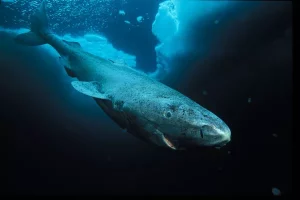
Venturing into the icy depths of the Arctic and North Atlantic, the Greenland shark remains one of the most enigmatic species in the shark kingdom. Known for its slow growth rate and extreme longevity, this elusive shark has captivated scientists and researchers.
Arctic Adaptations:
Adapted to life in cold, deep waters, Greenland sharks exhibit a slow metabolism and cold tolerance. Feeding on fish, seals, and carrion, these sharks navigate the frigid Arctic depths with remarkable resilience.
Remarkable Longevity:
Studies suggest that Greenland sharks have an extraordinary lifespan, potentially reaching several centuries. This longevity has spurred scientific interest, with ongoing research seeking to unravel the mysteries of their slow growth and extended lifespans.
Conservation Challenges:
While not extensively targeted by commercial fisheries, Greenland sharks face threats such as bycatch in longline fisheries and the impacts of climate change on their Arctic habitats. Conservation efforts involve understanding their biology, mitigating bycatch, and promoting sustainable practices in the Arctic seas.
6. Tiger Shark (Galeocerdo cuvier):
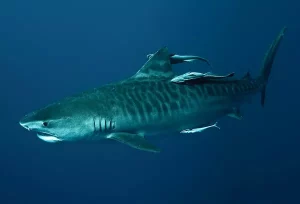
Named for its distinctive vertical stripes resembling those of a tiger, the tiger shark ranks among the largest predatory sharks. With a broad diet that includes fish, seals, birds, and even garbage, these sharks showcase remarkable adaptability.
Global Distribution:
Tiger sharks inhabit tropical and subtropical waters worldwide, showcasing a preference for coastal regions. Their extensive range encompasses the Atlantic, Indian, and Pacific Oceans, making them a truly cosmopolitan species.
Versatile Diet:
Tiger sharks are known for their opportunistic feeding habits. Their diverse diet includes a wide array of prey, and they are often referred to as the “garbage cans of the sea” due to their willingness to consume almost anything.
Conservation Considerations:
Tiger sharks face threats from overfishing, habitat loss, and the impact of plastic pollution. Conservation efforts focus on implementing responsible fishing practices, protecting critical habitats, and raising awareness about the ecological importance of these apex predators.
7. Hammerhead Shark (Sphyrnidae):
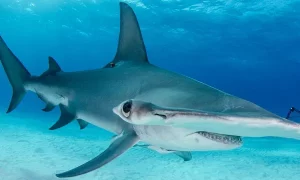
Characterized by their distinctive hammer-shaped heads, hammerhead sharks comprise several species, with the great hammerhead being one of the largest. These sharks are known for their unique physiology and social behavior.
Ecological Role:
Hammerhead sharks play a crucial role in maintaining the health of coral reef ecosystems. Their distinctive heads, known as cephalofoils, enable enhanced sensory perception and maneuverability, aiding in the hunt for prey.
Social Structure:
Some hammerhead species exhibit social behavior, forming schools during migration and breeding seasons. These schools can comprise hundreds of individuals, showcasing a level of social complexity not commonly associated with sharks.
Conservation Concerns:
Hammerhead sharks face threats from overfishing, driven by demand for their fins in the shark fin trade. Conservation efforts focus on regulating shark finning, establishing marine protected areas, and promoting sustainable fishing practices.
8. Shortfin Mako Shark (Isurus oxyrinchus):
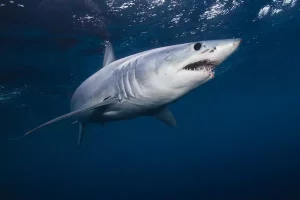
As one of the fastest sharks in the ocean, the shortfin mako shark combines speed with agility, making it a formidable predator. Known for its striking appearance and exceptional swimming capabilities, this species is a marvel of marine adaptation.
Speed and Agility:
Shortfin mako sharks are capable of reaching impressive speeds, making them proficient hunters. Their streamlined bodies, powerful tails, and warm-blooded physiology contribute to their ability to pursue fast-moving prey.
Global Distribution:
These sharks inhabit both offshore and oceanic waters, with a wide distribution that includes tropical and temperate seas. Their extensive range showcases their adaptability to diverse marine environments.
Conservation Challenges:
Shortfin mako sharks face overfishing due to their value in commercial and sport fisheries. Concerns about population declines have prompted calls for sustainable fishing practices, catch limits, and international cooperation to ensure their conservation.
9. Nurse Shark (Ginglymostoma cirratum):
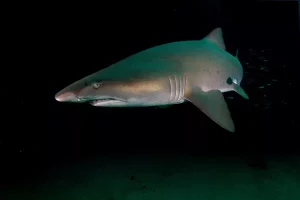
Inhabiting warm coastal waters, nurse sharks are known for their distinctive features, including barbels that resemble whiskers. These bottom-dwelling sharks play a unique role in marine ecosystems.
Benthic Lifestyle:
Nurse sharks are primarily benthic, meaning they reside on the ocean floor. Their sluggish and sedentary behavior contrasts with the more active hunting strategies of some other shark species.
Reproductive Behavior:
Nurse sharks exhibit interesting reproductive behavior, with females capable of storing sperm for extended periods. This biological adaptation contributes to the species’ reproductive success.
Conservation Status:
While not a target of commercial fisheries, nurse sharks face threats from habitat degradation and the impact of irresponsible tourism. Conservation efforts involve the establishment of marine protected areas and initiatives to promote responsible interactions with these unique sharks.
10. Oceanic Whitetip Shark (Carcharhinus longimanus):
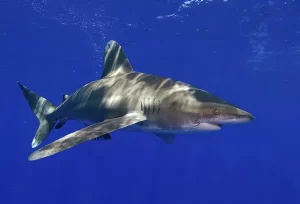
Thriving in the vastness of the open ocean, the oceanic whitetip shark is a species adapted to life far from coastal shores. Recognizable by its long, white-tipped dorsal fin, this shark is well-suited to the challenges of the pelagic environment.
Pelagic Adaptations:
Oceanic whitetip sharks possess physiological adaptations, such as large pectoral fins, that enhance their ability to cover long distances in open waters. These adaptations contribute to their success as nomadic predators.
Ecological Significance:
As an apex predator in the open ocean, oceanic whitetip sharks play a crucial role in regulating the populations of pelagic species. Their presence helps maintain the balance of the marine food web in deep-sea ecosystems.
Conservation Considerations:
Oceanic whitetip sharks face threats from bycatch in longline fisheries and the impact of overfishing. Conservation efforts involve the implementation of measures to reduce bycatch, such as using circle hooks, and the establishment of marine protected areas to safeguard their habitats.
Conclusion
In the vast expanse of the world’s oceans, these 10 largest shark species reign as guardians of the deep blue. From the filter-feeding grace of the whale shark to the swift agility of the shortfin mako, each species contributes to the intricate tapestry of marine life. As we strive to understand, protect, and coexist with these remarkable creatures, we pave the way for a future where sharks continue to thrive as vital components of Earth’s oceans.
You Might Be Interested In:

